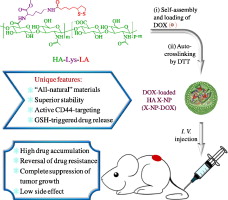Zhiyuan Zhonga,*(钟志远)
a Biomedical Polymers Laboratory, and Jiangsu Key Laboratory of Advanced Functional Polymer Design and Application, College of Chemistry, Chemical Engineering and Materials Science, Soochow University, Suzhou 215123, PR China
b Department of Pathology, School of Biology and Basic Medical Sciences, Soochow University, Suzhou 215123, PR China
Journal of Controlled Release 2015, 205, 144–154
The existence of drug resistance poses a major obstacle for the treatment of various malignant human cancers. Here, we report on reduction-sensitive reversibly crosslinked hyaluronic acid (HA) nanoparticles based on HA-Lys-LA conjugates (Lys: l-lysine methyl ester, LA: lipoic acid) for active targeting delivery of doxorubicin (DOX) to CD44 + breast cancers in vitro and in vivo, effectively overcoming drug resistance (ADR). HA-Lys-LA with degrees of substitution of 5, 10 and 28% formed robust nano-sized nanoparticles (152–219 nm) following auto-crosslinking. DOX-loaded crosslinked nanoparticles revealed inhibited DOX release under physiological conditions while fast drug release in the presence of 10 mM glutathione (GSH). Notably, MTT assays showed that DOX-loaded crosslinked HA-Lys-LA10 nanoparticles possessed an apparent targetability and a superior antitumor activity toward CD44 receptor overexpressing DOX-resistant MCF-7 human breast cancer cells (MCF-7/ADR). The in vivo pharmacokinetics and biodistribution studies in MCF-7/ADR tumor xenografts in nude mice showed that DOX-loaded crosslinked HA-Lys-LA10 nanoparticles had a prolonged circulation time and a remarkably high accumulation in the tumor (12.71% ID/g). Notably, DOX-loaded crosslinked HA-Lys-LA10 nanoparticles exhibited effective inhibition of tumor growth while continuous tumor growth was observed for mice treated with free drug. The Kaplan–Meier survival curves showed that in contrast to control groups, all mice treated with DOX-loaded crosslinked HA-Lys-LA10 nanoparticles survived over an experimental period of 44 days. Importantly, DOX-loaded crosslinked HA nanoparticles caused low side effects. The reversibly crosslinked hyaluronic acid nanoparticles with excellent biocompatibility, CD44-targetability, and effective reversal of drug resistance have a great potential in cancer therapy.

链接:
//www.sciencedirect.com/science/article/pii/S0168365915000334#